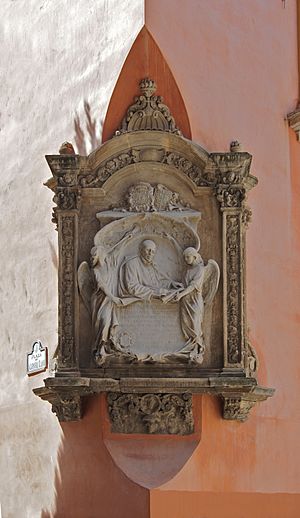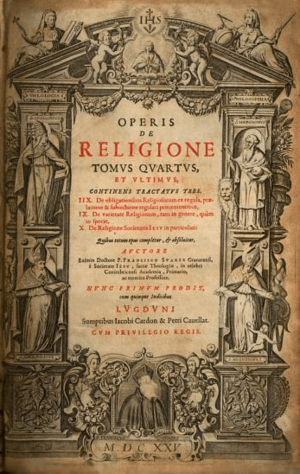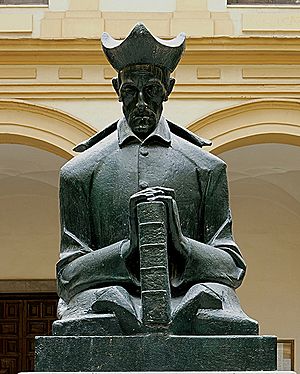Francisco Suárez facts for kids
Quick facts for kids
Francisco Suárez
|
|
|---|---|
 |
|
| Born | 5 January 1548 |
| Died | 25 September 1617 (aged 69) |
| Other names | Doctor Eximius |
| Alma mater | University of Salamanca |
| Era | Early modern philosophy
|
| Region | Western philosophy
|
| School | Scholasticism Medieval realism School of Salamanca |
|
Main interests
|
Theology, metaphysics |
|
Notable ideas
|
The object of metaphysics is being insofar as it is real being |
Francisco Suárez (January 5, 1548 – September 25, 1617) was a Spanish Jesuit priest, philosopher, and theologian. He was a very important figure in the School of Salamanca movement. Many people consider him one of the greatest thinkers after Thomas Aquinas. His work helped change scholasticism, moving it from the Renaissance period to the Baroque period. Famous thinkers like Leibniz and Descartes were inspired by his ideas.
Contents
Life and Career
Francisco Suárez was born in Granada, Spain, on January 5, 1548. His family had some Jewish background.
When he was 10, he started his studies. In 1561, at age 13, he went to the University of Salamanca to study law. In 1564, at 16, Suárez joined the Society of Jesus (the Jesuits). He spent two years training with Father Alonso Rodriguez. In 1566, he became a Jesuit and began studying Theology at Salamanca. He wasn't a great student at first. He even failed his entrance exam twice! But he passed on his third try, and things got better.
In 1570, Suárez started teaching philosophy. He taught at Salamanca and then at the Jesuit college in Segovia. He became a priest in 1572. He continued teaching philosophy until 1574, when he moved to Valladolid to teach theology. He taught theology for the rest of his life in many different places, including Rome (1580–85) and Salamanca (1592–97). In 1597, he moved to Coimbra, Portugal, to become the main theology professor at the University of Coimbra. He stayed there until he died in 1617.
Suárez wrote about many different topics. He produced a huge amount of work, with his complete writings in Latin filling 26 volumes. His books covered law, the relationship between the Church and the government, metaphysics (the study of reality), and theology (the study of God). Some people call him the "godfather of International Law." His book Disputationes metaphysicae (Metaphysical Discussions) was very popular in Europe in the 1600s. Many scholars think it's his most important work.
During his lifetime, Suárez was seen as the greatest living philosopher and theologian. He was even given the nickname Doctor Eximius et Pius, meaning "Exceptional and Pious Doctor." Pope Gregory XIII attended his first lecture in Rome. Pope Paul V asked him to argue against the ideas of James I of England. Philip II of Spain sent him to the University of Coimbra to make it more famous. When Suárez visited the University of Barcelona, the university's professors came out to meet him, wearing their special academic clothes.
After he died in Portugal, his fame grew even more. He directly influenced famous philosophers like Hugo Grotius, René Descartes, and Gottfried Leibniz.
Philosophical Ideas
Suárez's most important philosophical ideas were in metaphysics and the philosophy of law. He is often seen as the last major thinker in scholasticism, a way of thinking that combined faith and reason. He followed some of the ideas of Thomas Aquinas but also developed his own system of metaphysics.
Metaphysics
For Suárez, metaphysics was the study of what is truly real. It focused on real things rather than just ideas, and on things that are not physical. He believed that for God, being and existence are the same. But for created things, like humans or objects, he argued that their "essence" (what they are) and their "existence" (that they are) are not truly separate. They are only different in how we think about them.
He also had ideas about universals. These are general concepts like "humanity" or "redness." Suárez tried to find a middle ground between two main ideas. One idea was that universals exist as real things outside our minds. The other idea was that universals are just names or ideas in our minds. Suárez believed that the only real unity in the world is the individual thing. For example, the "humanity" of one person is not truly the same as the "humanity" of another person. There are as many "humanities" as there are people. However, he also thought that this shared nature isn't just made up by our minds. It exists "in the nature of the thing" before we even think about it.
Suárez's work on metaphysics was a big effort to organize medieval thought. He combined ideas from different schools of thought, like Thomism and Nominalism. He was known as the greatest metaphysician of his time. He even started his own school of thought called Suarism. Some of its main ideas included:
- That individual things are what make them unique.
- That our minds can directly understand individual things.
- That there's a difference between what a created thing is (its essence) and that it exists (its existence).
- That God is infinite being, and created things are finite beings.
In his book Disputationes Metaphysicae (1597), Suárez explored the idea of "being" and how it's divided. He made a key difference between ens infinitum (infinite being, which is God) and ens finitum (finite being, which are created things). He saw this as the most basic way to divide all that exists. He also discussed entia rationis (beings of reason). These are things that our minds can imagine but cannot actually exist in reality.
Theology
In theology, Suárez followed the ideas of Luis Molina. Molina tried to explain how God's plan for people (predestination) works with human free will. Suárez tried to combine this with other ideas about God's grace. He said that everyone gets enough grace from God. But for those chosen by God, there's a special grace that fits their situation perfectly. This grace helps them freely choose to follow God's influence. This idea was called "congruism."
Philosophy of Law
Suárez was very important for his ideas on natural law and positive law. Natural law is about rules that are part of human nature, given by God. Positive law is made by humans. In his big book, Tractatus de legibus ac deo legislatore (Treatise on Laws and God the Lawgiver, 1612), he was a pioneer for later thinkers like Hugo Grotius. He made a clear difference between natural law and international law. He saw international law as being based on customs between nations.
Suárez believed that all power to make laws comes from God. He also thought that the authority of every law comes from God's eternal law. However, he disagreed with the idea that kings had a "divine right" to rule, meaning their power came directly from God without any input from people.
He argued that humans have a social nature given by God. This means they have the ability to create laws. But when a society forms, the government's power comes from humans, not directly from God. People choose how their government will be. They give their power to the ruler. Because they gave this power, they also have the right to take it back. They can revolt against a ruler if the ruler acts badly. However, they must act carefully and fairly. They should not kill the ruler, even if he is a tyrant. But if a government is forced upon people, then they have the right to defend themselves. They can revolt and even kill a tyrannical ruler in that case.
Suárez was influenced by Thomas Aquinas in his law philosophy, but they had some differences. Aquinas defined "law" as a rule that guides actions for the common good. Suárez thought this definition was too broad. He also believed that law is mainly an act of will, not just reason. He disagreed with Aquinas's idea that God could change some natural laws, like the rules against murder or theft. Suárez argued that natural law is fixed as long as human nature stays the same.
In 1613, Suárez wrote a book called Defensio catholicae fidei contra anglicanae sectae errores (Defense of the Universal Catholic Faith Against the Errors of the Anglican Sect). He wrote it for Christian leaders in Europe. This book was against the oath of allegiance that King James I made his subjects take. King James, who was also a scholar, ordered Suárez's book to be burned. He also complained to Philip III of Spain for allowing an enemy of kings to live in his country.
Influence
Suárez's ideas about metaphysics and theology had a big impact on thinkers in the 1600s and 1700s. This was true for both Catholics and Protestants.
Because the Jesuit order was strong, Suárez's Disputationes Metaphysicae was widely taught in Catholic schools in Spain, Portugal, and Italy. It also spread to many Lutheran universities in Germany. There, students who preferred Philipp Melanchthon's views on philosophy over Martin Luther's studied his text. In some 17th-century Lutheran universities, the Disputationes was even used as a philosophy textbook.
Suárez also had a major influence on the Reformed tradition in German and Dutch schools. This included his ideas on metaphysics and law, especially international law. For example, Hugo Grotius (1583-1645) praised his work highly. His influence was so widespread that in 1643, a Dutch Reformed theologian named Jacobus Revius wrote a whole book to respond to Suárez's ideas. Suárez's book De legibus was considered one of the best law books by the Puritan Richard Baxter. Baxter's friend Matthew Hale used Suárez's ideas for his own theory of natural law.
Main Works
- De Incarnatione (1590–1592) - About the Incarnation of Christ.
- Disputationes metaphysicae (1597) - His famous work on metaphysics.
- De legibus (1612) - His important book on laws.
- Defensio fidei (1613) - His defense of the Catholic faith.
Many of Suárez's complete works were published in Venice (1740–1751) and Paris (1856–1861). His Disputationes Metaphysicae was published 17 times between 1597 and 1636. Today, there isn't a modern complete edition of his works, and only a few of his writings have been translated into English.
Images for kids
See also
 In Spanish: Francisco Suárez para niños
In Spanish: Francisco Suárez para niños
- Giovanni Botero
- Jurisprudence
- Political philosophy
- School of Salamanca





